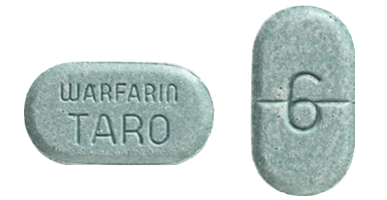Warfarin Side Effects
Hemorrhaging is the most commonly reported warfarin side effect. This blood thinner may also cause pain, bloating and nausea. Serious side effects include skin necrosis and kidney damage.
Article Continues Below

Board-certified physicians medically review Drugwatch.com content to ensure its accuracy and quality.
Drugwatch.com partners with Physicians’ Review Network Inc. to enlist specialists. PRN is a nationally recognized leader in providing independent medical reviews.
Reviewer specialties include internal medicine, gastroenterology, oncology, orthopedic surgery and psychiatry.
Drugwatch.com has been empowering patients for more than a decade
Drugwatch.com has provided reliable, trusted information about medications, medical devices and general health since 2008. We’ve also connected thousands of people injured by drugs and medical devices with top-ranked national law firms to take action against negligent corporations.
Our team includes experienced medical writers, award-winning journalists, researchers and certified medical and legal experts. Drugwatch.com is HONCode (Health On the Net Foundation) certified. This means the high-quality information we provide comes from credible sources, such as peer-reviewed medical journals and expert interviews.
The information on Drugwatch.com has been medically and legally reviewed by more than 30 expert contributors, including doctors, pharmacists, lawyers, patient advocates and other health care professionals. Our writers are members of professional associations, including American Medical Writers Association, American Bar Association, The Alliance of Professional Health Advocates and International Society for Medical Publication Professionals.
About Drugwatch.com
- Assisting patients and their families since 2008.
- Helped more than 12,000 people find legal help.
- A+ rating from the Better Business Bureau.
- 5-star reviewed medical and legal information site.
Testimonials
"Drugwatch opened my eyes to the realities of big pharmacy. Having a family member with major depression and anxiety, I was looking for information on her medications. I found information that was very helpful, that her psychiatrist never told her."
- Common Side Effects
- Bleeding, abdominal pain, bloating, flatulence, nausea, vomiting and an altered sense of taste
- Serious Side Effects
- Fatal hemorrhaging, purple toe syndrome, warfarin-induced skin necrosis, calciphylaxis (calcium buildup in blood vessels), kidney damage and emboli
- Boxed Warning
- Warfarin contains a boxed warning for increased risk of bleeding and encourages doctors to monitor INR levels in their patients. INR refers to how long it takes blood to clot.
Recent Warfarin Side Effects Information
As of June 30, 2024, delayed blood clotting, adverse drug interactions, hemorrhaging and gastrointestinal bleeding were the most common warfarin side effects reported to the U.S. Food and Drug Administration. Bruising was also common.
| FDA Adverse Event Reports for Warfarin Side Effects | |
|---|---|
| Total cases reported | 88,420 |
| Serious cases (including deaths) | 71,479 |
| Deaths | 9,735 |
Disclaimer: Reports sent to the FDA don’t necessarily mean the drug caused an adverse event. Consult a health care professional before stopping or changing medication.
Clinical trials showed that between 0.6% and 3% of the study participants had a major bleeding incident. Underlying health conditions and drug interactions may increase this risk. Warfarin products contain a boxed warning about its association with bleeding risks.
Common Side Effects
Many patients taking warfarin experience gastrointestinal symptoms. These are often manageable with lifestyle changes and over-the-counter medications.
Warfarin can also affect your sense of taste and may contribute to hair loss.
- Abdominal pain
- Altered sense of taste
- Bleeding
- Bloating and gas
- Diarrhea
- Hair loss
- Nausea and vomiting

Bleeding is a common side effect of warfarin and other medications that inhibit vitamin K. This is because vitamin K helps your blood clot. Patients may have increased bruising and excessive bleeding from seemingly minor injuries. Doctors can administer vitamin K injections in an emergency to increase clotting.
Serious Side Effects
Warfarin can cause serious side effects such as organ and tissue damage and hemorrhaging. Patients on this medication should monitor themselves for symptoms.
- Embolism caused by a ruptured plaque
- Calcification in blood vessels
- Hemorrhaging
- Kidney damage
- Tissue necrosis
While most of these serious side effects are rare, they may still pose a health risk. You should be aware of the risks and report any serious symptoms to your doctor as soon as possible.
Increased Bleeding Risk with Warfarin
Hemorrhaging is the most common warfarin side effect received through the FDA reporting system. In extreme cases, even a small cut could cause excessive bleeding in patients on warfarin. Without intervention, too much blood loss can be fatal.
Bleeding often occurs when warfarin-containing medications cause an elevated International Normalized Ratio (INR). High INR levels indicate slower-than-normal clotting times.
- Anemia
- Being 65 or older
- Certain genetic factors
- Diabetes
- History of a highly variable INR measure
- History of gastrointestinal bleeding
- High blood pressure
- History of stroke
- History of heart disease
- Kidney problems
- Using certain medicines together with warfarin, for example, aspirin
- Using warfarin for a long time period
Certain factors, such as having a history of bleeding disorders, diabetes, kidney problems, high blood pressure or being over the age of 65, can increase the risk of bleeding when taking warfarin.
“Warfarin metabolism can be affected by reduced renal function and hepatic function, which is more prevalent in older patients,” clinical pharmacist Kenneth S. Fill told Drugwatch.
“Additionally, patients with bleeding disorders can be at an increased risk of complications from warfarin such as tissue necrosis or calciphylaxis, which requires extra monitoring.”
Some common painkillers, including aspirin, ibuprofen and naproxen, can also increase your bleeding risk – especially if taken with warfarin.
In 2006, the FDA issued a boxed warning for the increased risk of bleeding among patients taking warfarin. It recommends routine testing of INR levels and patient education.
Tissue Necrosis and Calciphylaxis
Tissue death is a rare complication that may start within a few days of beginning warfarin therapy. Improper blood supply causes tissue death, which can lead to gangrene and breakdown.
Symptoms of warfarin-induced necrosis often begin with a painful red discoloration on the skin. This may progress to a blue or black discoloration. Typically, this symptom develops on the thighs, breasts, penis or buttocks. These patches eventually develop large bloody blisters. If left untreated, necrosis can affect internal organs and lead to death.
Another cause of warfarin-associated necrosis is calciphylaxis. This is a condition where calcium deposits block arteries. Painful red or purple web-like patterns on the skin are among the earliest symptoms of calcium buildup. These purplish lesions often appear on the legs and look similar to skin necrosis lesions.
According to a 2023 case study published in Practical Dermatology, survival rates for necrosis caused by warfarin-induced calciphylaxis range from 48% to 78%.
Case Study: Warfarin-Induced Gangrene in a 45-Year-Old Man
A case study in The Journal of Clinical and Aesthetic Dermatology discusses a 45-year-old man with a history of deep vein thrombosis (DVT) and pulmonary embolism (PE). Three months after starting warfarin, the patient presented with severe foot pain. He was admitted to the ICU due to respiratory failure and altered mental status.
Clinical Findings
Examination revealed noninflammatory purpura — purplish internal bleeding — and life-threatening skin lesions on his feet. An ultrasound confirmed multiple blood clots.
The medical team stopped warfarin and administered vitamin K and fresh frozen plasma. Despite treatment, the patient required partial amputations of both feet due to severe tissue damage.
Conclusion
This case highlights the importance of early recognition and treatment of warfarin-induced venous limb gangrene to prevent severe outcomes.
Managing Side Effects
While you may not be able to remove all risks of taking warfarin, you can reduce your chances of having a serious adverse reaction.
Do not take warfarin with other pain relievers unless specifically instructed by your doctor, as they may increase your bleeding risk.
- Carefully monitor blood levels and clotting times to reduce bleeding risk
- Take your medication exactly as prescribed
- Use a soft-bristled toothbrush to minimize gum bleeding
Your doctor should carefully monitor blood levels to help ensure your safety while taking warfarin. Patients on warfarin must undergo INR tests monthly to determine how quickly their blood clots.
Warfarin Alternatives
Alternatives to warfarin became widely available in the 2010s. Some doctors now favor newer medication classes that don’t inhibit vitamin K.
However, warfarin is still the preferred blood thinner for some patients.
- Eliquis (apixaban)
- Bevyxxa (betrixaban)
- Pradaxa (dabigatran)
- Lixiana (edoxaban)
- Xarelto (rivaroxaban)
Warfarin is a vitamin K antagonist that blocks the body’s ability to synthesize Vitamin K for blood clotting purposes.
Newer blood thinner classes, such as direct oral anticoagulants, work by blocking the proteins involved in binding blood cells together. These drugs are also called factor Xa inhibitors.
“Compared to warfarin, the new anticoagulants have a more predictable dose response, making them less of a bleeding risk,” Fill said. “These newer medications also generally interact with less medications compared to warfarin.”
While direct oral anticoagulants are often better tolerated compared to warfarin, they still pose an increased risk of bleeding.
You should discuss your concerns about side effects with a health care provider to see if warfarin or DOACs are a better choice for your treatment.
Editor Lindsay Donaldson contributed to this article.
Calling this number connects you with a Drugwatch.com representative. We will direct you to one of our trusted legal partners for a free case review.
Drugwatch.com's trusted legal partners support the organization's mission to keep people safe from dangerous drugs and medical devices. For more information, visit our partners page.


